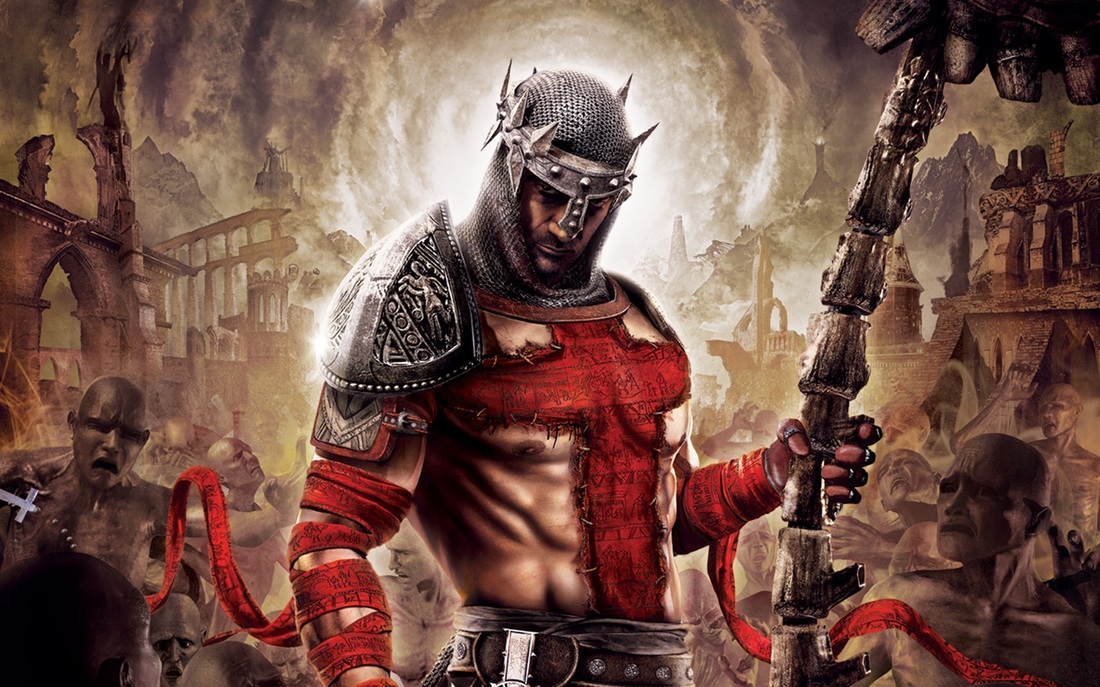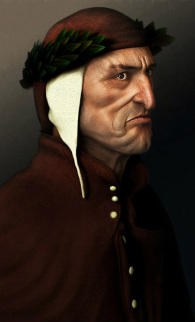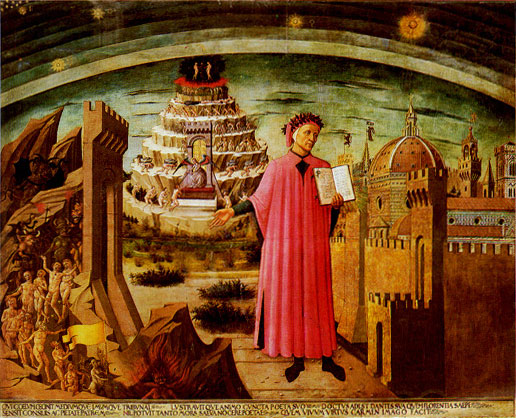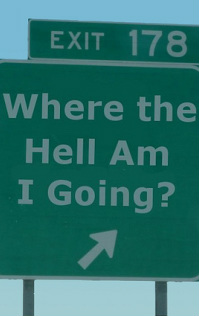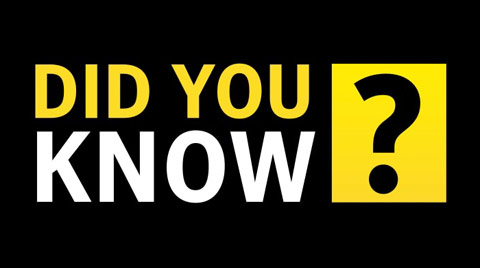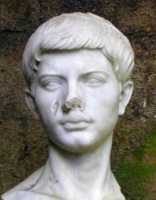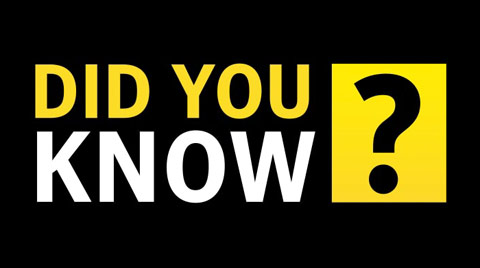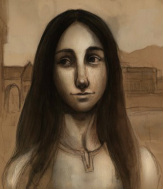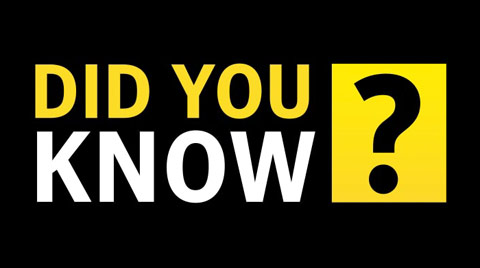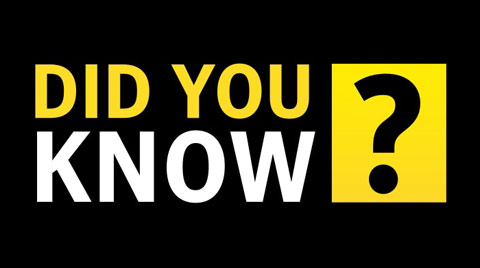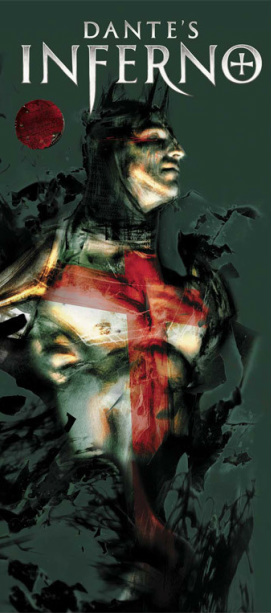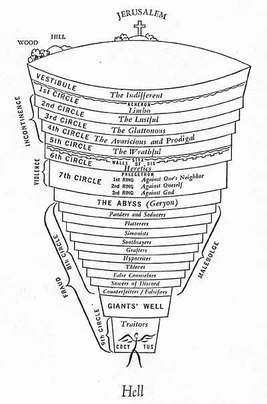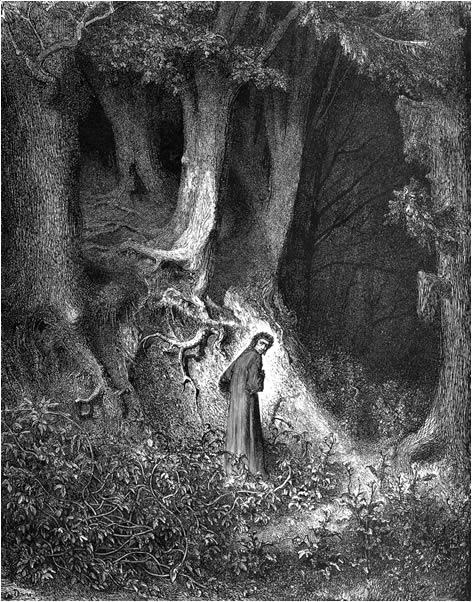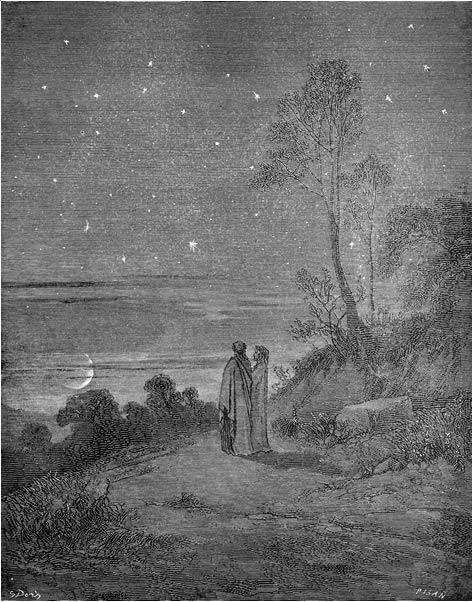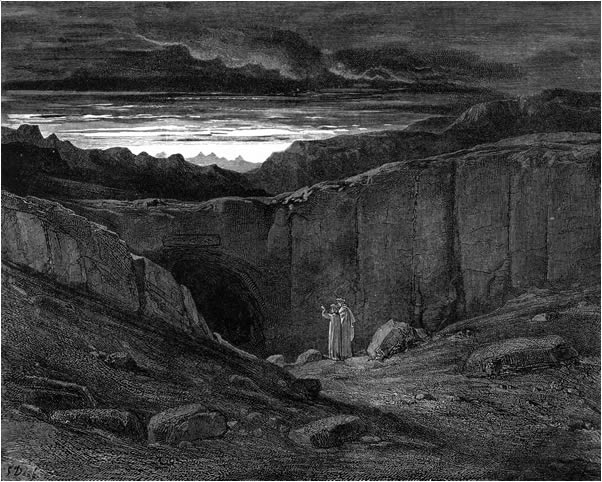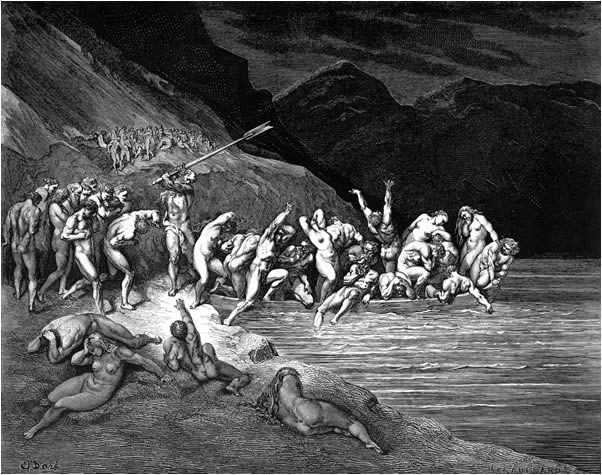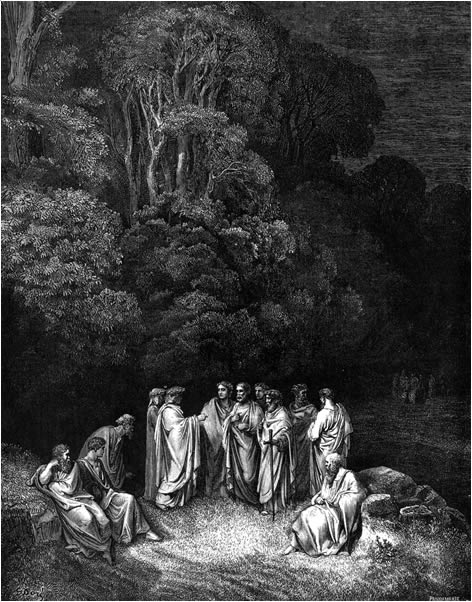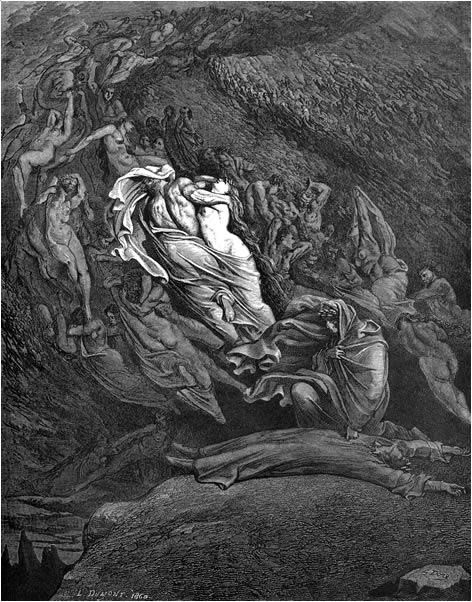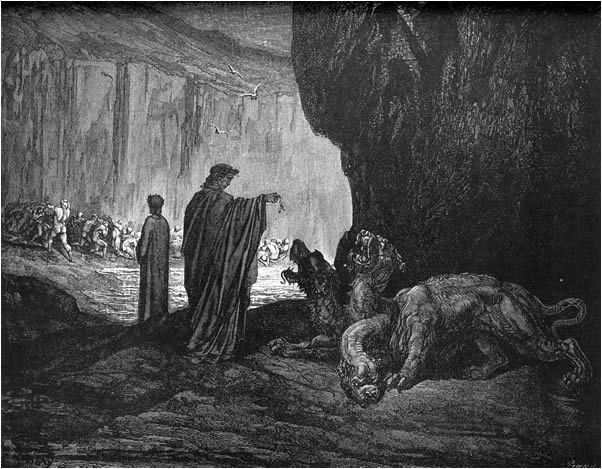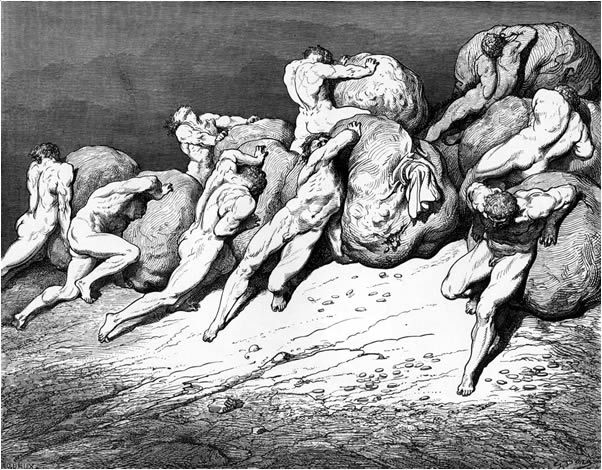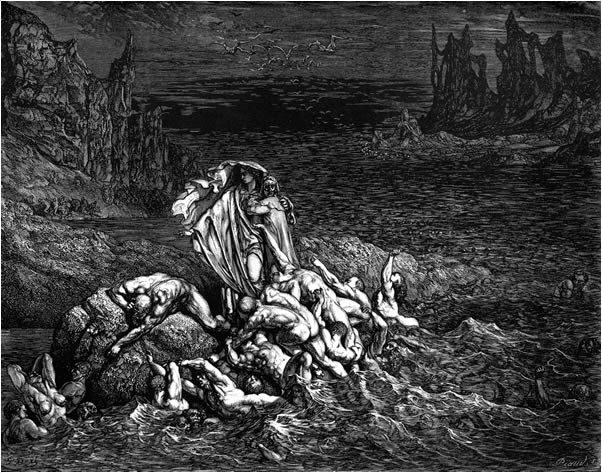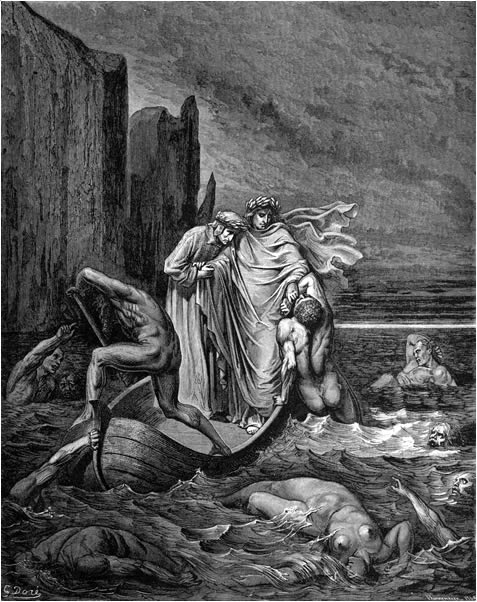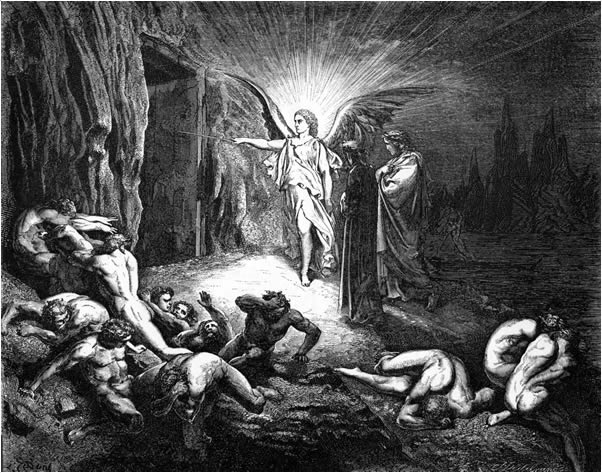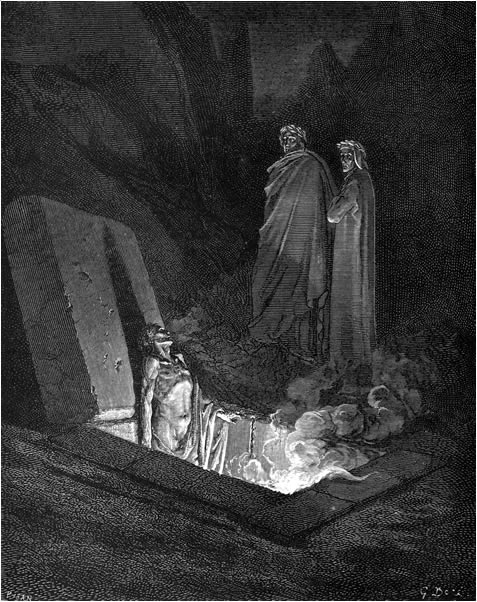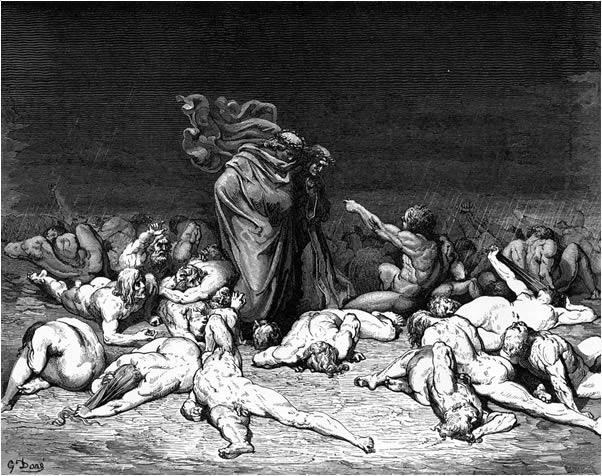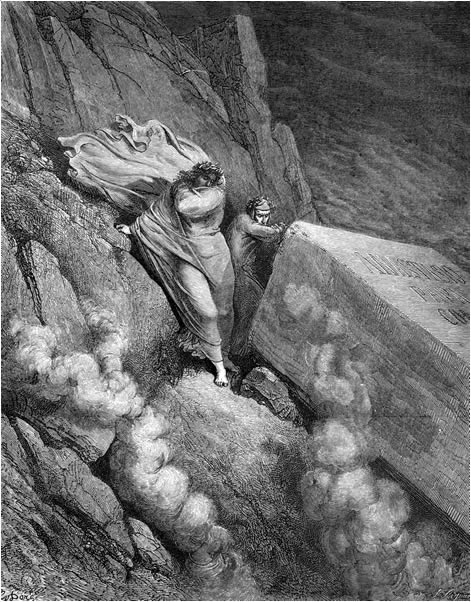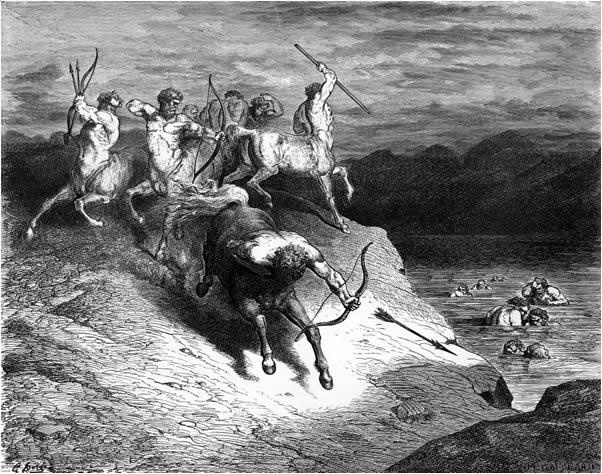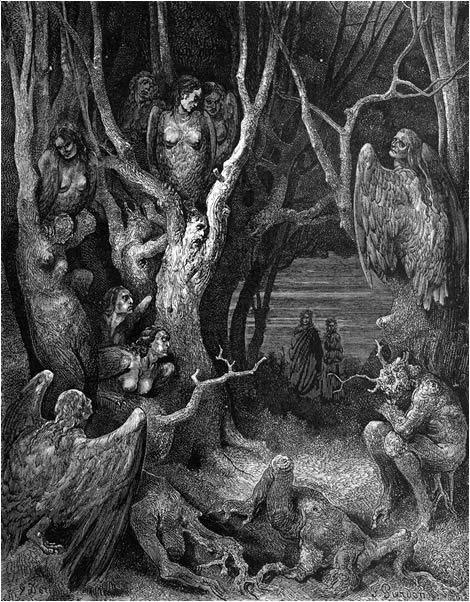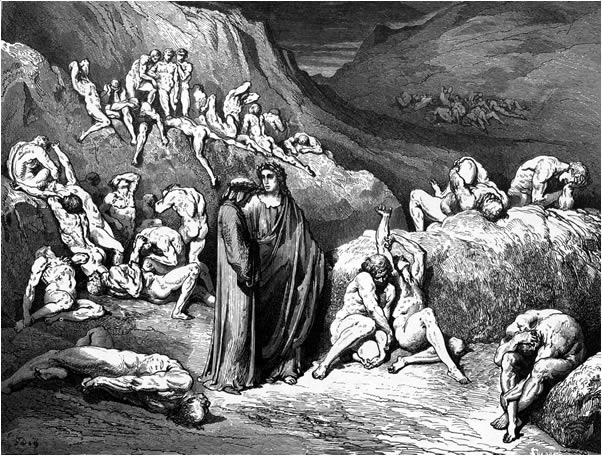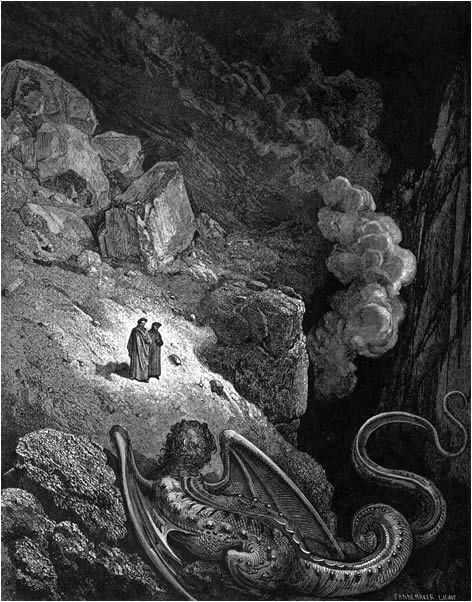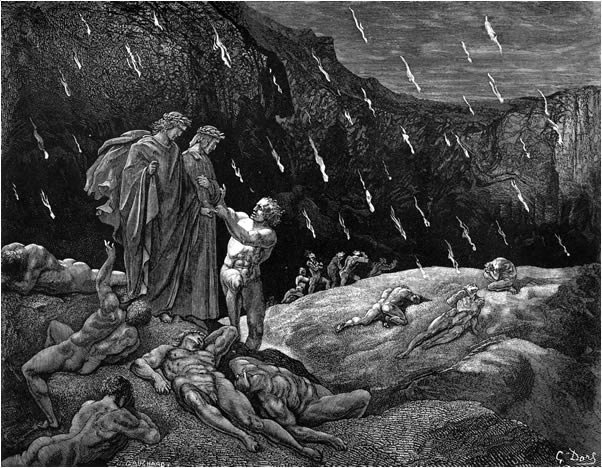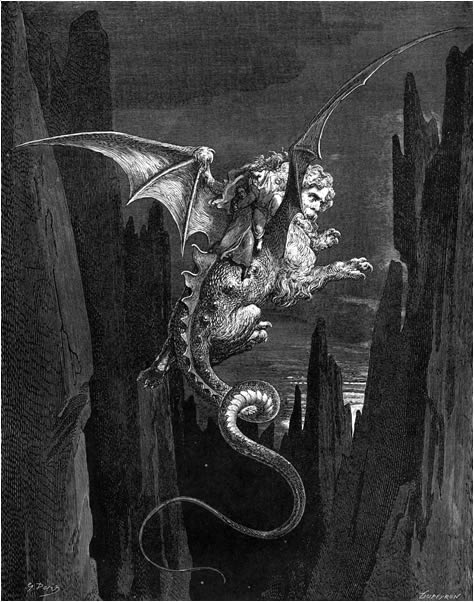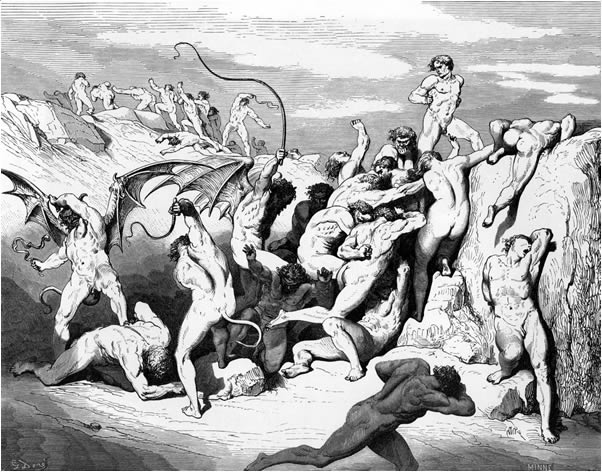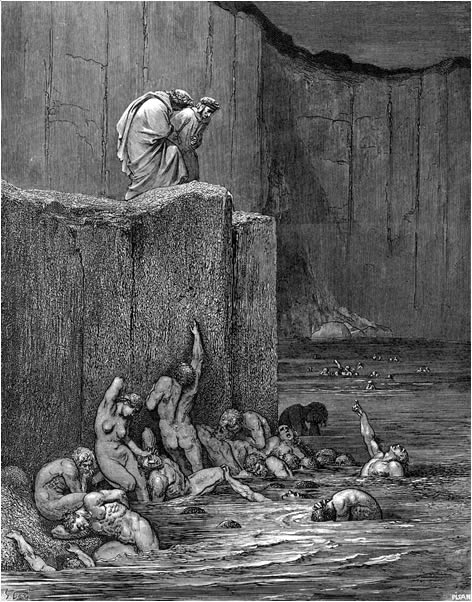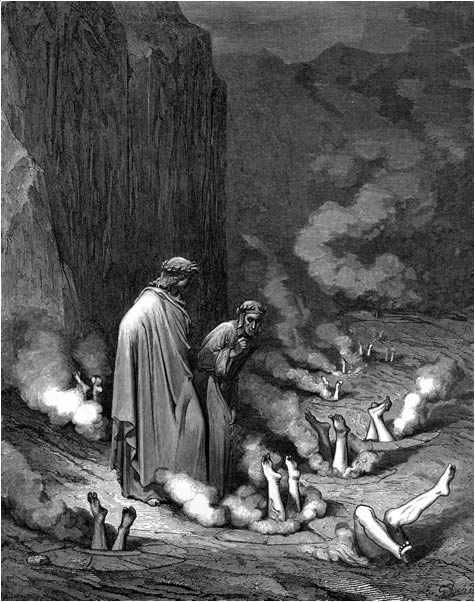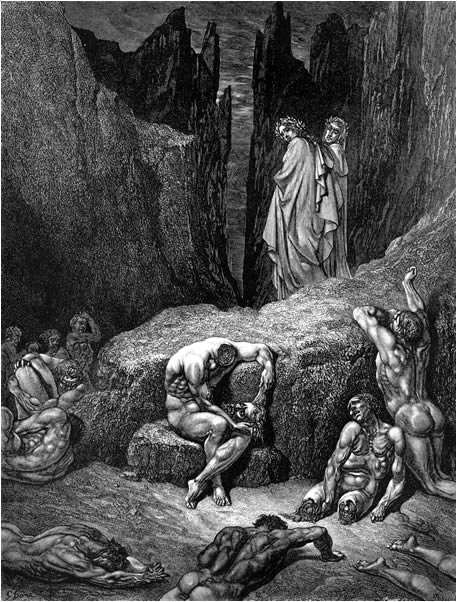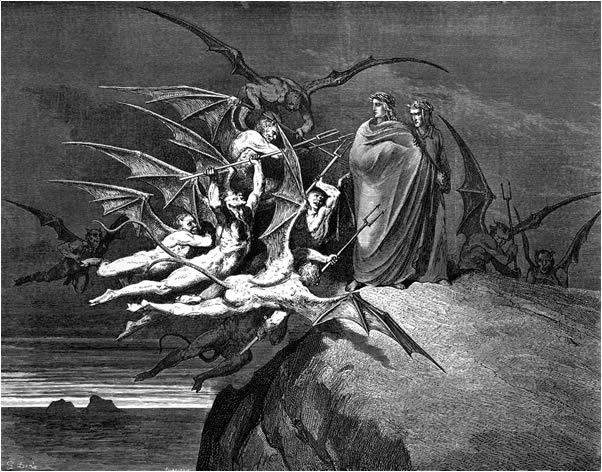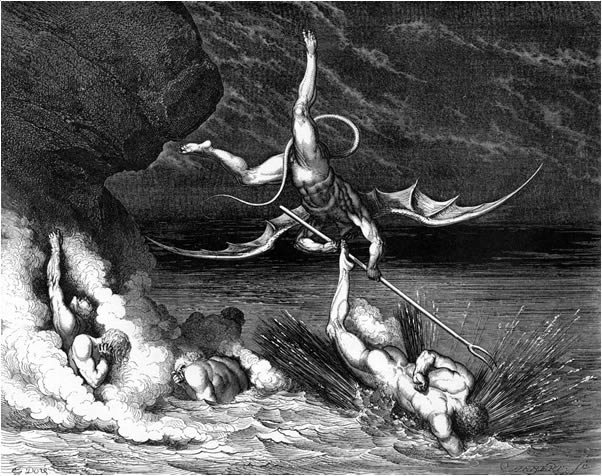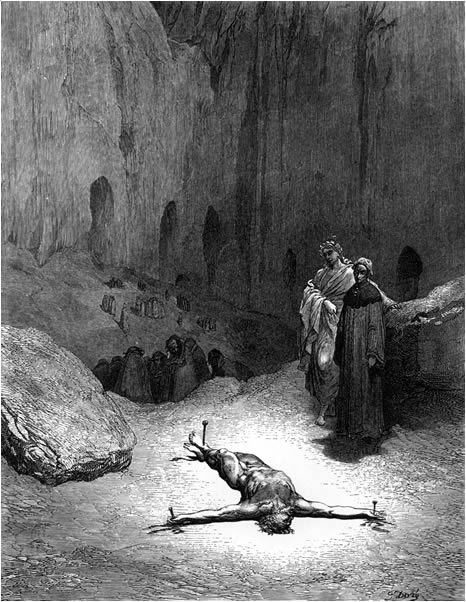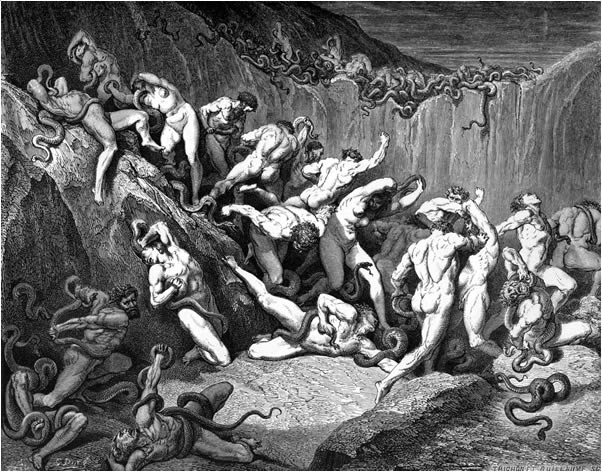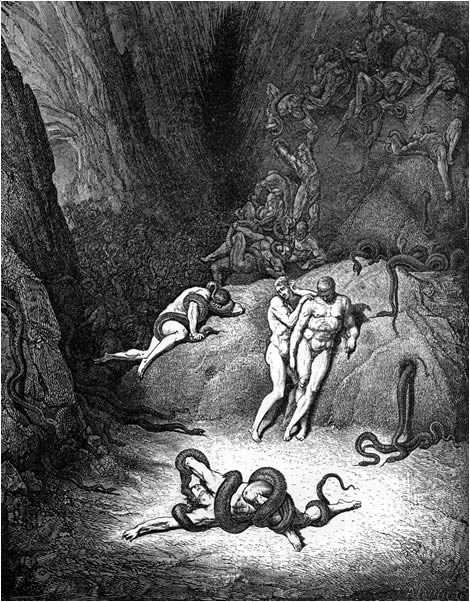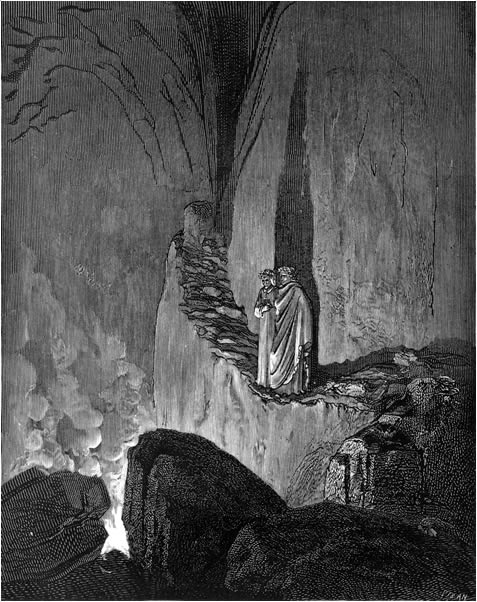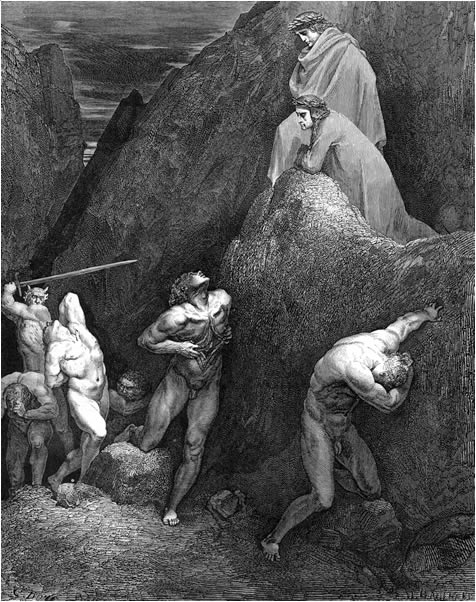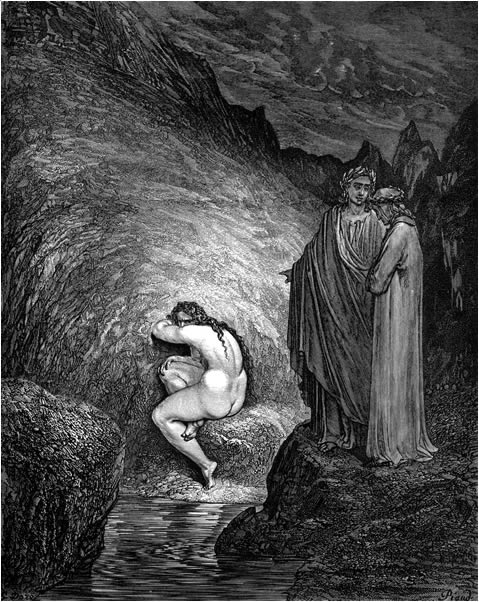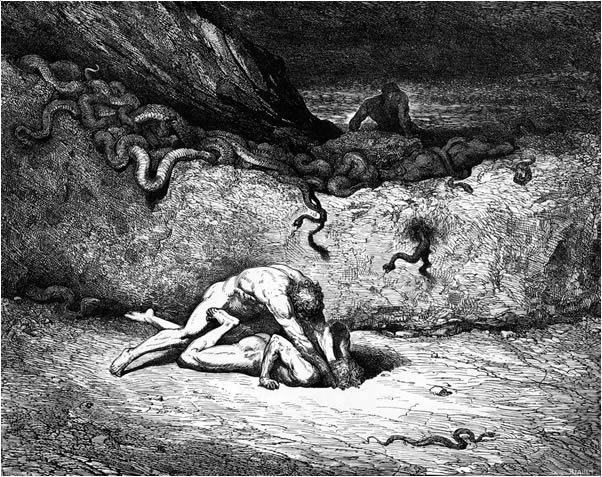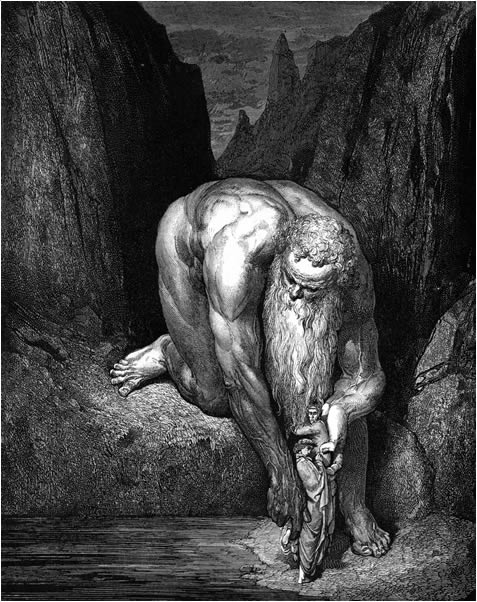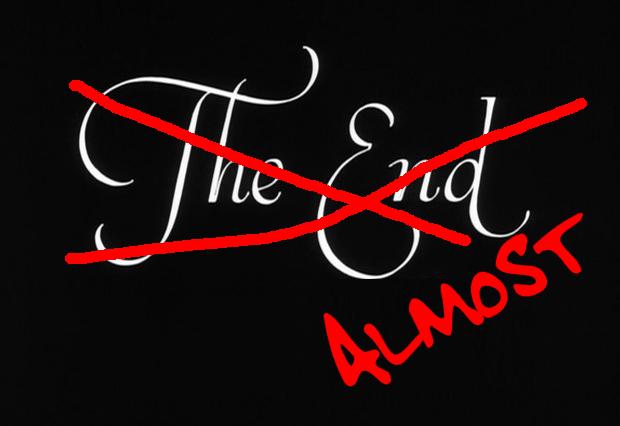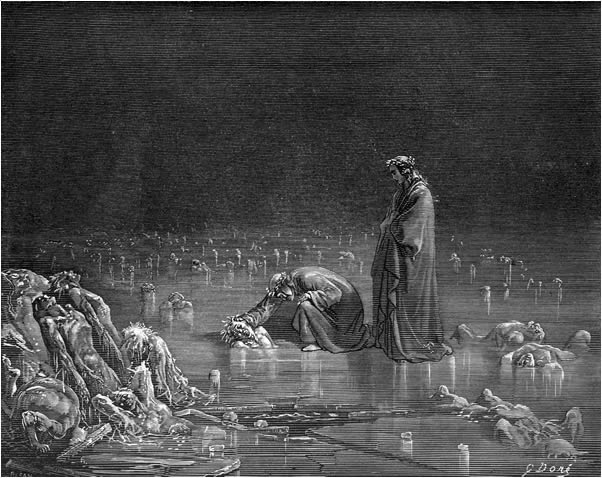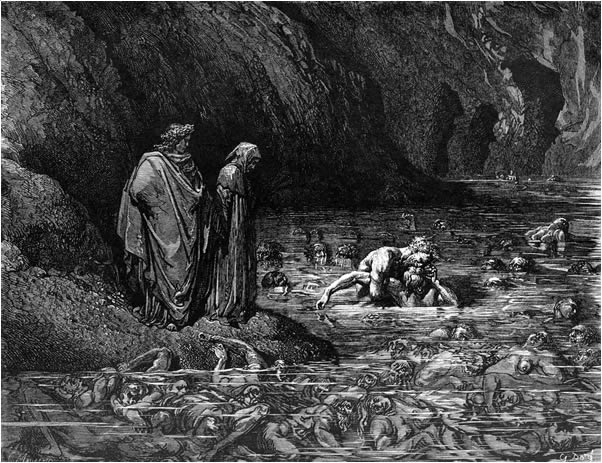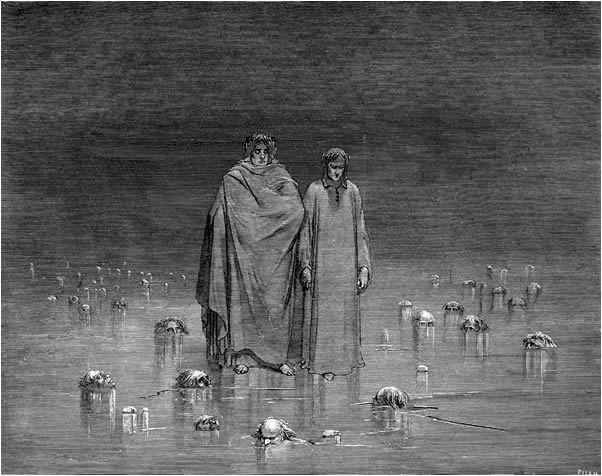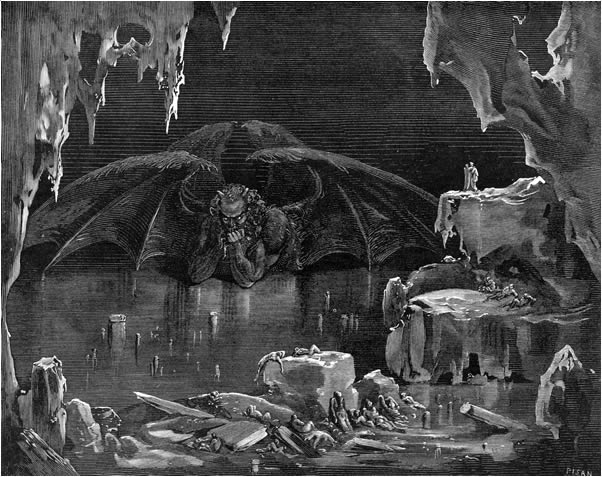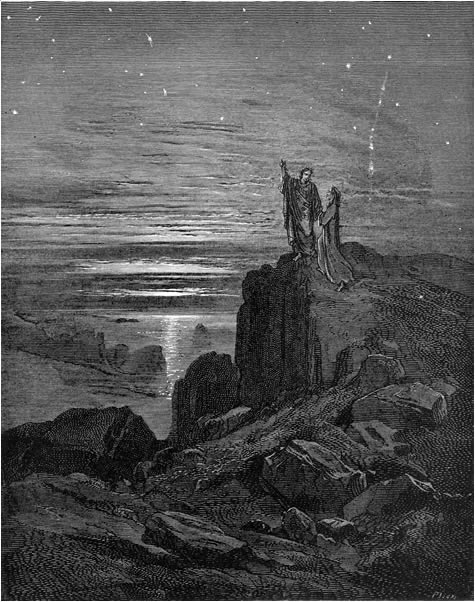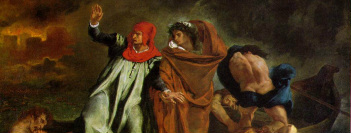Scramblin' thru... Dante's Inferno
Canto #1: 7:00pm on "Holy Thursday", April 7, 1300 – The Dark Woods
|
Dante, then 35, realizes he is lost in the Dark Woods of worldliness, ignorance, and
sin. He tries to escape by climbing a sunlit mountain (which symbolizes the quest for enlightenment) but is blocked by 3 beasts, each representative of the 3 major "sins": a leopard (lust), a lion (pride), and a she-wolf (greed). (Dante admits to having committed the first two sins.) They drive him back until he has no place to go. Suddenly, Virgil arrives, explaining that "he has been sent to lead Dante from error." Virgil says that the only way for Dante to get to Purgatory, and then go on to Heaven, is through Hell. He then offers himself as Dante's guide. |
Canto #2: 6:30pm on "Good Friday", April 8th – Foot of the Mountain
|
Virgil explains that God has sanctioned Dante's rehabilitation, and Virgil, as an embodiment of reason, is only the messenger and agent.
Virgil describes how the Virgin Mary, distressed at Dante's situation, summoned Beatrice, who, in turn, enlisted the aid of Virgil. The Virgin Mary is usually seen as the embodiment of love, mercy, and compassion. Beatrice, whose name signifies blessedness, represents revelation, and is the core link in Dante's journey to salvation. After Virgil explains all this, they continue on their way. |
Canto #3: 7:00pm, April 8th – Vestibule of Hell: The Indifferent
|
The Poets (as Dante refers to Virgil and himself) first arrive at the Gate of Hell. The gate itself is tall and wide, with no bars or door. The inscription above the open Gate of Hell is especially ominous ("Abandon all hope, ye who enter here"). Dante is made aware of the judgmental nature of God.
The Vestibule houses the Indifferent, those who were neither good nor bad and who contributing nothing while on Earth. Since they took no place in life, neither do they in death. Included here are those that didn't take a side in the rebellion of the angels. Since they aren't in Hell, these people have no place to go, and they rush around chasing a flag forever. Behind the running herds are wasps that sting them and cause blood to run down their backs. The stinging indicates the pettiness of what irritated them in life. The river Acheron [pronounced: Ack-er-on, means: "joyless"] flows between the Vestibule and Hell itself. The banks of Acheron are crowded with souls waiting to be ferried across by Charon [pronounced: Care-on] the boatman. The Poets hitch a ride across to the First Circle. |
Canto #4: 8:00pm, April 8th – First Circle (Limbo): Unbaptized Pagans
|
Hell is set up in a series of circles that spiral downward, like an inverted wedding cake. The Poets then begin their descent to the First Circle of Hell (Limbo).
Limbo was invented by the early Church to serve as the abode of 2 groups: unbaptized children and the virtuous patriarchs of the Old Testament. These figures abide in a splendid castle representing natural wisdom without Christian faith, from which emanates the light of human genius. |
Canto #5: 9:00pm, April 8th – Second Circle: The Carnal & Lustful
|
The Poets come across Minos, the half-man, half-beast that decides to which circle each sinner will be damned.
The Poets find themselves on a ledge overlooking a great whirlwind. Within the winds are the souls of the Carnal and Lustful. Because the blind, uncontrolled desire for sex swept them away in life, so in Hell they are being swept away for eternity. It is dark because they are being denied God's warmth. |
Canto #6: 11:45pm, April 8th – Third Circle: The Gluttonous
|
In this circle a mixture of stinking snow and freezing rain falls from the sky. The souls here lie swollen in the icy mixture and are guarded by Cerberus, the 3-headed dog of Hell.
These souls are Gluttons, and each is alone in degradation, cold, and misery. Since these people wallowed in food and drink and produced nothing but garbage in life, in Hell they wallow in garbage and receive no food or drink. |
Canto #7: 12:15am, April 9th – Fourth & Fifth Circles: Greedy & Wrathful
|
The Poets encounter 2 masses of sinners here. The group to the left is made up of Hoarders; the group to the right is made up of Wasters.
Both groups were so extreme in their use (or non-use) of money. The Hoarders push weights in sacks to the center of the circle; then the Wasters push the sacks back out of the center of the circle. The Poets head toward the Fifth Circle, but before they can get there, they reach the River Styx, which looks more like a stagnant marsh. Here the Wrathful are punished. On the surface are muddy figures furiously attacking each other, while the more sullen ones (those who kept their wrath bottled up inside themselves) are sunk beneath the surface in filthy slime. |
Canto #8: 1:00am, April 9th – Outside the City of Dis
|
The Poets wait on the shore of the River Styx for Phlegyas [pronounced: Fley-guy-as] to ferry them across. Dante watches a wrathful soul torn to pieces by the others.
As Phlegyas' boat gets closer to the shore Dante can see the fiery red towers of Dis, the capital of Hell. The walls of the city block the way to "Lower Hell". The Poets step out of the boat to find themselves in front of an iron gate that's guarded by the Rebellious Angels. They refuse to let the Poets pass, so Virgil says a prayer for Heaven to assist them. |
Canto #9: 2:00am, April 9th – Sixth Circle: The Heretics
|
This entire canto is dominated by a sense of fear. While they are waiting for Divine aid, the 3 Furies (snake-haired goddesses) suddenly appear at the top of a tower and summon Medusa to turn Dante to stone. Virgil covers Dante's eyes and warns him against looking at the Gorgon.
At that moment, a storm shakes Hell, and the Heavenly messenger arrives. With his touch, the gates fly open as he yells at the Rebellious Angels. (Unlike popular belief in which demons and angels constantly fight each other, the demons and sinners in Dante's Hell are terrified of angels and don't try to confront them.) Inside Dis are the Heretics. The sin of heresy (belief that contradicts religious teaching) is the only sin punished in Dante's Hell that is specifically Christian. All others are potential moral failings for any human and any religion. (In other words, you could have a gluttonous Buddhist or a lustful Hindu, but witches are solely sinners within the Christian faith.) The Sixth Circle is separated from the circles above or below. Because these sinners denied Christianity, they are kept outside. The Heretics are trapped inside tombs that are wrapped in flames. |
Canto #10: 3:00am, April 9th – Still in Sixth Circle
|
Still in the Sixth Circle, the Poets walk by a soul that Dante recognizes. This soul is one of Dante's enemies on Earth, and he and Dante begin to talk about politics and argue. (Boooooring.)
There are several instances throughout The Inferno in which Dante uses his poem to rip on people that made him mad or who were mean to him in "real" life. (You know, because deep down, Dante was a 5-year-old.) |
Canto #11: 4:00am, April 9th – Leaving Sixth & approaching Seventh
|
While leaving the Sixth Circle, the Poets find a great pile of rocks that had once been a cliff but had collapsed because of an earthquake.
They look down and see the Seventh Circle, but because the air is so foul they are forced to take shelter behind a tomb until they can grow accustomed to the stench. For the rest of this un-dramatic canto, Virgil informs Dante how Hell is organized and that the Seventh Circle is subdivided into 3 rings. |
Canto #12: 4:30am, April 9th – Seventh Circle, 1st Ring: Those Violent Against Others
|
The Poets are menaced by a Minotaur (man's body; bull's head). This batch of sinners, Those Violent Against Others includes murderers, war makers, tyrants, robbers, and terrorists. They are immersed in the river Phlegethon [pronounced: Fley-geth-on], which is made of boiling blood.
The seriousness of their sin determines how deeply in it they are sunk. Any sinner that tries to get out is shot with an arrow by Centaurs (man's body and head; horse's legs). |
Canto #13: 5:00am, April 9th – Seventh Circle, 2nd Ring: Those Violent Against Oneself
|
The canto opens with 6 instances of "no" or "not" in the first 7 lines, indicating Dante's hatred of suicide.
In the 2nd Ring of the Seventh Circle, the Poets enter the Woods of the Suicides where Those Violent Against Oneself are punished. These souls are encased in trees, whose limbs are torn off by harpies(woman's body/head; bird's wings/feet). Blood (not sap) rush out, and only while it is pouring are the souls allowed to speak. |
Canto #14: 5:15am, April 9th – Seventh Circle, 3rd Ring: Those Violent Against God
|
The 3rd ring of the Seventh Circle consists of a sandy plain rained upon by eternal fire, clearly signifying the wrath of God for these sinners. All the sinners here went against the Divine plan for human existence.
There are 3 groups of sinners within this ring. The Blasphemers: These sinners insulted God; frequently took Lord's name in vain; openly defied God. They are slowly stretched out as they lie facing the Heaven they scorned. The Sodomites: These sinners engaged in/desired anal sex. They sinned against "Nature" (God's intended plan of sex to reproduce). They run in endless circles chasing the "caboose" of the person in front of them (but never getting it). The Usurers: These sinners loaned $ but charged too much interest. They sinned against "Industry" (God's intended plan for $). Dante believed it was a sin to profit by lending money. They are forced to crouch over their $ bags forever. |
|
Canto #15: 5:30am, April 9th – Still in Seventh Circle, 3rd Ring
|
The Poets continue to roam around the 3rd
Ring of the Seventh Circle, following a large stream of blood that cuts its way across the burning sand. The blood is carried in a channel whose banks are made of stone. The Poets stay on the stone to keep from burning their feet. (This river flows into the Eighth and Ninth Circles.) |
Canto #16: 5:45am, April 9th – Still in Seventh Circle, 3rd Ring
|
The Poets, still in the 3rd Ring of the Seventh Circle, walk toward a huge waterfall that plunges into the Eighth Circle when 3 souls come running up to them.
These are 3 political figures that lived in Florence that Dante admired. They ask for news of Florence... and Dante gladly answers. This gives Dante a chance to give his opinion on how Florence is doing. (Sassy, isn't he?) |
Canto #17: 6:00am, April 9th – Still in Seventh Circle, 3rd Ring
Canto #18: 6:15am, April 9th – Eighth Circle, Bolgias 1 & 2: Panderers & Flatterers
|
The Poets find themselves in the Eighth Circle, made up of 10 sections or "pockets" called Bolgias [pronounced: Bowl-gee-ahs].
In Bolgia 1, Panderers (a.k.a. "Pimps") circle one way while naked Seducers (prostitutes and adulterers) walk by the other way. Both are driven by horned demons (whose horns are the traditional icon of adultery) that crack their whips to keep them moving. In Bolgia 2, the Poets see Flatterers who are sunken in human excrement from the world's latrines. Dante's disgust with the Flatterers is reflected in the briefness with which he talks to them before moving on. Most scholars agree that during Dante's time as a magistrate he most likely ran into his fair share of butt kissers. (So, the only logical thing to do would be to throw them all in Hell.) |
Canto #19: 6:30am, April 9th – Eighth Circle, Bolgia 3: The Simonists
|
The quiet contempt that Dante showed in the previous canto changes to righteous anger when he deals with the Simonists (church officials who sell and traffic sacred things or jobs in the church for a profit) in Bolgia 3. The use of one's ecclesiastical position for personal profit was regarded as an offense against the Holy Ghost, but to fit it into his scheme, Dante puts the Simonists into the category of fraud.
These sinners are placed upside down in round, tube-like holes with their feet on fire. The length of the flame is proportional to their guilt. Since the Simonists made a mockery of the holy office, they are turned upside down in a mock baptism. Instead of being baptized by water, they are baptized by fire. Dante crosses some lines by placing 3 Popes that "ruled" during his lifetime in these tubes of fire. |
Canto #20: 6:45am, April 9th – Eighth Circle, Bolgia 4: The Soothsayers
|
The Poets find Soothsayers (Fortune-Tellers) in Bolgia 4. Dante condemned astrology or any other system to foretell the future since he believed the Will of God determined the course of the universe.
Thus, the punishment for the Soothsayers is having their faces, which attempted to look into the future, fixed toward the rear. Their eyes, which attempted to see future events, are permanently blinded with tears. Still, Dante shows pity on this group of sinners, which results in him being scolded by Virgil since such a response questions God's judgment. It is possible that Dante's compassion derives from his once having dabbled in magic since magic was honored by the Ancient poets. In the Medieval mind, Virgil was seen as a magician, and Dante is clearly using this canto to dissociate his master from this popular misconception. |
Canto #21: 7:00am, April 9th – Eighth Circle, Bolgia 5: The Grafters
|
The next 2 cantos are devoted to the Grafters (people who are corrupt on a large scale). This can be attributed to a personal motive. Having served in political office from 1295-1300, Dante was accused of graft, a claim so absurd that not even his enemies really believed it. Dante did not care to respond to the accusations, and these cantos may be the reply he withheld at that time.
The Grafters are sunk in black, boiling water, corresponding to the dark, secretive atmosphere in which they used to do their dirty work. If they try to emerge, demons on the banks of the pool tear and claw at them with sharp hooks. |
Canto #22: 8:00am, April 9th – Still in Eighth Circle, Bolgia 5
|
While still in Bolgia 5, an unidentified sinner is hooked by a demon... and as he is being torn apart, Virgil questions him.
Dante then starts to talk to some of the other sinners, and as he does so, the one on the hook escapes. Two demons lunge after the escaped sinner and fall into the boiling water. As the other demons attempt to rescue their fallen comrades, the Poets quietly slip away. Awwwwkward... |
Canto #23: 9:00am, April 9th – Eighth Circle, Bolgia 6: The Hypocrites
|
Outrunning the demons, the Poets slide down the slope to Bolgia 6, just ahead of their pursuers. Dante observes a line of weeping sinners, clothed in golden cloaks lined with lead. These sinners are the Hypocrites.
Just as Dante begins to speak with them, he notices the shade of Joseph Caiaphas, crucified and transfixed by three stakes to the floor so that every sinner here must tread on him. (Caiaphas was the Jewish priest that put Jesus on trial.) |
Canto #24: 11:00am, April 9th – Eighth Circle, Bolgia 7: The Thieves
|
The Poets move down into the pit of Bolgia 7. Here serpents are coiled about the sinners, Thieves, binding their hands behind them and knotting themselves through their loins (yea, the Mommy/Daddy buttons).
A serpent flies toward a sinner and pierces the jugular vein, which causes the sinner to burst into flames, collapses to ashes, and then reforms. Just as thieves take away property, they now undergo disintegration throughout eternity. |
Canto #25: 11:45am, April 9th – Still in Eighth Circle, Bolgia 7
|
One of the thieves makes an obscene gesture and swears at God. Hearing this, the serpents attack him.
Some thieves have additional punishments depending upon the severity of their stealing in life. Some of them first appear to be humans... other reptiles. Then through a painful transformation, they change forms with each other. This is because in life they took other peoples' stuff and made it into their own. |
Cantos #26 & #27: 12:00pm, April 9th – Eighth Circle, Bolgia 8: The Deceivers
|
In Bolgia 8, the Deceivers (False Counselors) are punished. These sinners used their eloquence to mislead others. Because they possessed and misused higher human capacities than those of previous sinners, such as the thieves of the preceding canto, they have sinned more severely and are placed deeper in Hell.
These sinners are wrapped in tongues of fire, which conceal them just as in life their speech concealed their thought. Among these people the Poets see a great double-headed flame, which contains the literary hero Ulysses (a.k.a. Odysseus). Virgil talks to the flame, and Ulysses tells of his last voyage and death. After Ulysses' flame departs, the Poets continue to mull around the Eighth Circle. |
Canto #28: 1:00pm, April 9th – Eighth Circle, Bolgia 9: The Sowers of Discord
|
In Bolgia 9, the sinners are divided into 3 categories: Sowers of Religious Discord, Political Discord, and Discord Among Kinsmen.
All must walk around the edge of the circle. At one point in their journey, a demon armed with a sword cuts them from their chin to their groin. By the time they reach him again their wounds are healed and hacked anew. Two of the Sowers of Religious Discord include Islam's Muhammad and his son-in-law Ali. Modern readers may take offense to this blatant attack on Islam... however, in Dante's time, bad-blood between Muslims and Christians had carried over from the Crusades. |
Canto #29: 2:00pm, April 9th – Eighth Circle, Bolgia 10: The Falsifiers
|
Bolgia 10 is filled with Falsifiers. The ones described fall into 4 categories:
1. Falsifiers of Metals (Alchemists) 2. Falsifiers of Persons (Impersonators) 3. Falsifiers of Coins (Counterfeiters) 4. Falsifiers of Words (Liars) The Alchemists suffer from leprosy that changes their appearance, just as they themselves tried to change the appearance of things in the world. |
Canto #30: 3:00pm, April 9th – Still in Eighth Circle, Bolgia 10
|
This canto deals with the 3 remaining categories of Falsifiers: Impersonators, Counterfeiters, and Liars.
Unlike all other sinners in Hell, the Falsifiers are tortured from within themselves rather than from without. Just as the Alchemists in the previous canto were afflicted with leprosy, so the Impersonators are made insane, the Counterfeiters are given dehydration, and the Liars are tormented with a fever that makes them smell. (And nobody likes the stinky sick guy...) |
Canto #31: 4:00pm, April 9th – The Cliff between Eighth & Ninth Circles: The Giants
|
Crossing from the Eighth Circle to the central pit (a well at the bottom of which lies Cocytus, the Ninth Circle), the Poets find the Giants. They challenged the Greek gods in a battle and lost.
The Giants pose a severe threat because they combine evil will with physical power, so they are chained inside a stone well. The Giant Antaeus, while not chained like the other Giants because he did not participate in the assault upon the Greek gods, has a savage reputation in classical tales and is just as dumb as the others in this circle. Virgil promises the Giant that Dante will spread Antaeus' fame back on Earth in exchange for the vain Giant to lower them in the palm of his hand to the floor of Hell. |
And now the exciting conclusion to The Inferno...
Cantos #32 & #33: 5:00pm, April 9th – Ninth Circle: Traitors to Kin, Country, Friends & Masters
|
The river flowing from Circle 7 into Circle 8 now freezes in a circular plain at the bottom of Hell. The metaphor is clear, for the heart of the Traitor was the coldest heart of all.
That's right! The center of Dante's Hell... is FROZEN! Did you see THAT twist coming? No, you expected fire, didn't you?! That's soooo Puritan! The lake is called Cocytus [pronounced: Ko-kite-us] and contains 4 rings that freeze 4 groups: 1. Traitors to Kin 2. Traitors to Country 3. Traitors to Guests & Friends 4. Traitors to Their Masters. The Traitors in Cocytus differ from previous sinners in that they do not want news of themselves delivered to the world (like the Giant Antaeus desired). Such reports, they worried, would increase the hatred all ready held for them by the living. While they do not reveal their own identity, they eagerly betray the names and stories of those around them. |
|
Canto #34: 7:00pm, April 9th – Ninth Circle: The Devil
|
The traitors under the ice here are so deep we never know who they are. Only the greatest traitor of all, Lucifer, and the 3 souls he crunches in his jaws, are identifiable.
Cast from Heaven for rebelling against God, Lucifer (Satan, Dis, Beelzebub, etc.) is fixed for eternity with his upper body protruding into Hell. Frozen into the ice from which flow all the rivers of guilt, Lucifer tries to escape by batting his wings but just freezes himself into place. Lucifer has 6 wings, a pair beneath each face. From the wings under the face of hatred proceeds the wind of fraud (Circles 8-9); from the pair under the face of ignorance comes the wind of violence (Circle 7); and from the pair under the face of impotence comes the wind of incontinence, or lack of self-control (Circles 1-5). Fraud, violence, and incontinence are the 3 key groups of sins in Dante's Hell. Judas Iscariot, the betrayer of Jesus Christ, is chewed by the red face of hatred. His head is stuck in one of Satan's jaws while his legs dangle uselessly outside. Marcus Brutus and Cassius, betrayers of their country through their assassination of Julius Caesar, are only slightly less abominable (remember, Dante is an Italian). Brutus is placed in the black face of ignorance and Cassius in the whitish-yellow face of impotence. Both are placed inside feet first so their heads stick out. Virgil announces that their journey of Hell is complete. Climbing down Satan's hairy back (gross, right?!), Virgil leads Dante through a crack in the ice and out the other side. From this point on they no longer descend because they have passed through the center of Earth and face an upward climb to the Mountain of Purgatory. Without stopping, they follow a winding path toward Earth's surface. Just before dawn on Easter Sunday, they emerge again to see the stars. |
|
THE END OF DANTE'S INFERNO!
Dr. Hartnell strongly urges you to read the next two sections (Purgatory and Paradise) to round out Dante's epic journey.
The Top 10 Reasons to Read... Divine Comedy by Dave Lafferty |
10. The Divine Comedy is a gripping and fascinating journey through the afterlife unequaled in literature.
Many scholars believe that The Divine Comedy is the greatest single work of poetry ever written. In the words of T.S Elliot: "Dante and Shakespeare divide the world between them – there is no third."
9. The story is as exciting and fresh today as it was in the 14th Century.
Monsters, adventure, politics, sex, love, relationships, good and evil... this story has it all.
8. It can be enjoyed and appreciated on many levels.
Besides being the ultimate adventure, The Divine Comedy is loaded with history, intrigue, allegory, religion, and even comedy (Dante puts butt-kissers in human poop! Classic!).
7. This is a work that can't be read just once.
Like all great literature, this work demands multiple readings. It speaks to us wherever we are in life's journey, and grows as we grow.
6. It covers the whole range of emotions.
Frustration, confusion, terror, rage, compassion, and love. And that's just in the first part!
5. It's an education in theology, philosophy, and history.
Learn about the classical philosophers, artists, and poets as well as the political, and religious leaders of Dante's lifetime.
4. The inhabitants of Dante's Hell remind us some people we know.
Let's face it, maybe somebody at Westerville North? Maybe you?
3. Souls don't always end up where you think.
Popes in Hell... Killers in Heaven... It's all about redemption and mercy!
2. Everyone loves a story about a journey.
Earth, Hell, Purgatory, Heaven. The greatest journey. (Besides, love-sick teeange vampires and werewolves are soooo 2008...)
1. It has a feel-good ending.
After a rough start, Dante ends up in Heaven. This is ultimately a story of hope.

